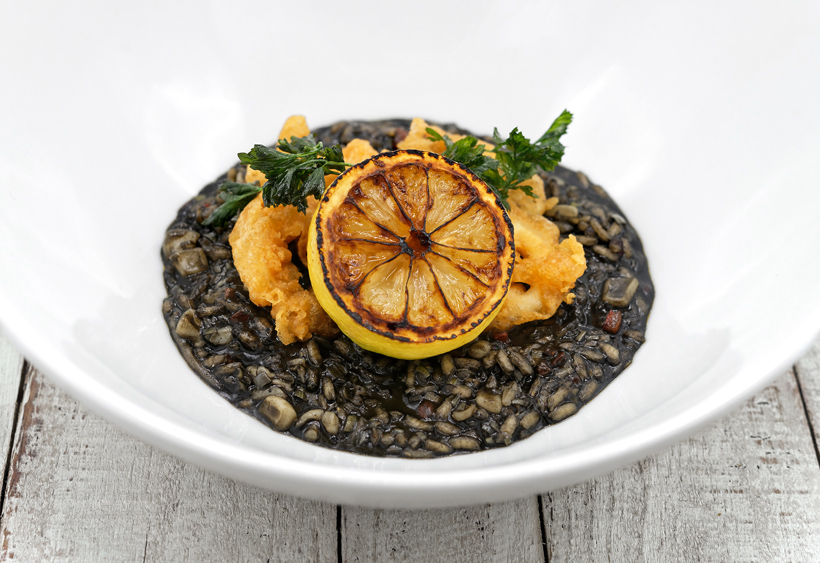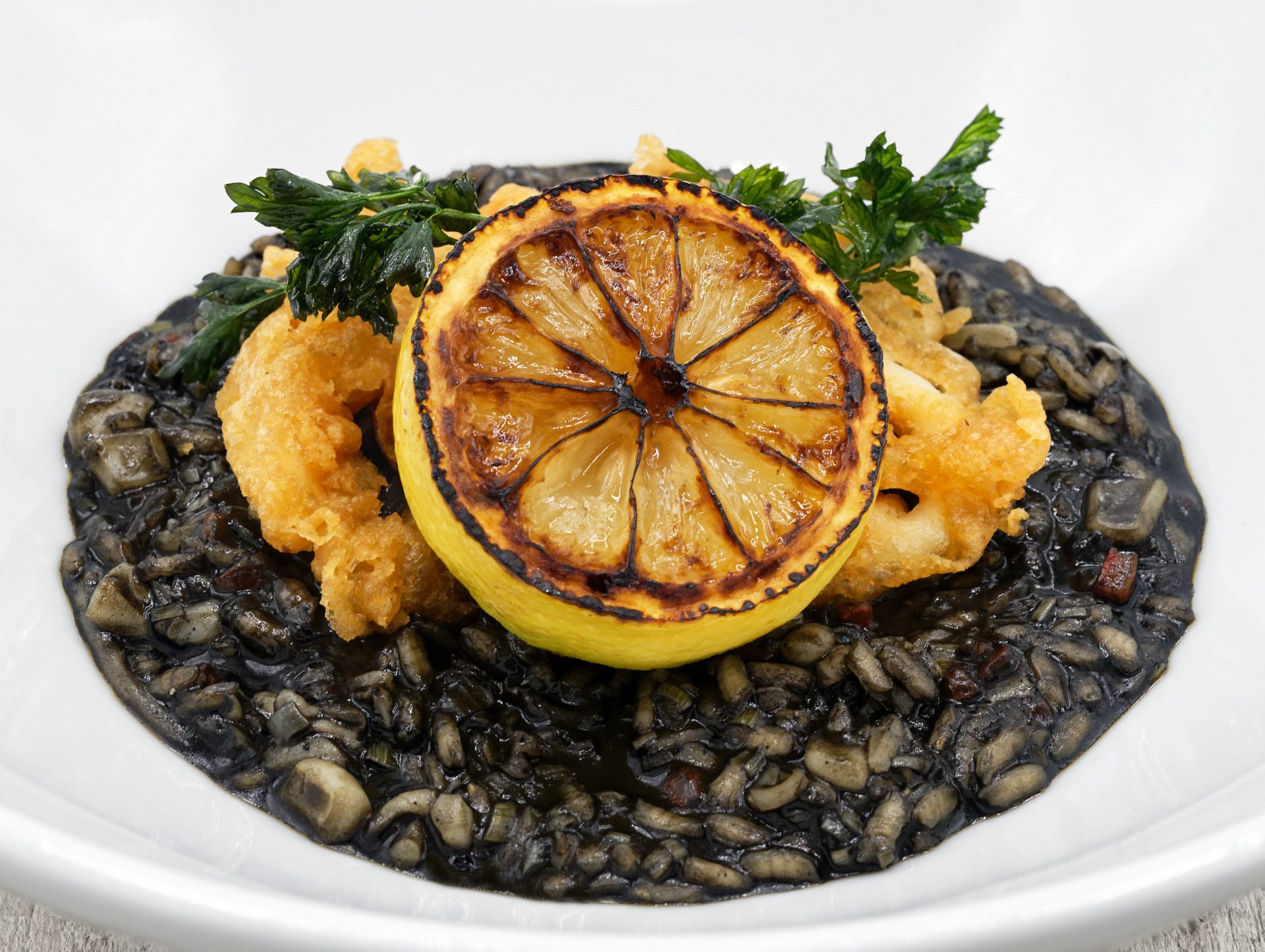It’s about time I start covering some of the traditional recipes of Croatian cuisine. After my review of Zadar’s Pet Bunara restaurant, where we had an orzo nero, I figured I would start by tackling a very similar dish, one of Dalmatia’s most iconic: crni rižot, black risotto made with cuttlefish ink.
You probably know squid and squid ink, but what is cuttlefish? In short, it’s a cephalopod like squid and octopus, though with a unique internal shell, the cuttlebone. Larger in size than squid, it provides more ink and more meat.
At its core, crni rižot isn’t a very complicated dish: it’s just risotto with cuttlefish chunks and maybe some tomato, colored with cuttlefish ink. I’m including below a translation of Aldo Ivanišević’s recipe from Dalmatinska Kuhinja (Dalmatian Cuisine), probably the most authoritative book on the subject, and that’s exactly how he prepares it. But more interesting is the section that follows (also translated below), which Ivanišević calls “additional ingredients and spices” and which is longer than the recipe itself! There, in a chaotic jumble, Ivanišević mixes run-of-the-mill complements like lemon juice and pepper with off-the-beaten-path ideas such as salted sardines, olive paste, and blanched almonds. Far from being weighed down by debilitating traditions, readers are empowered to use virtually any ingredient they like.
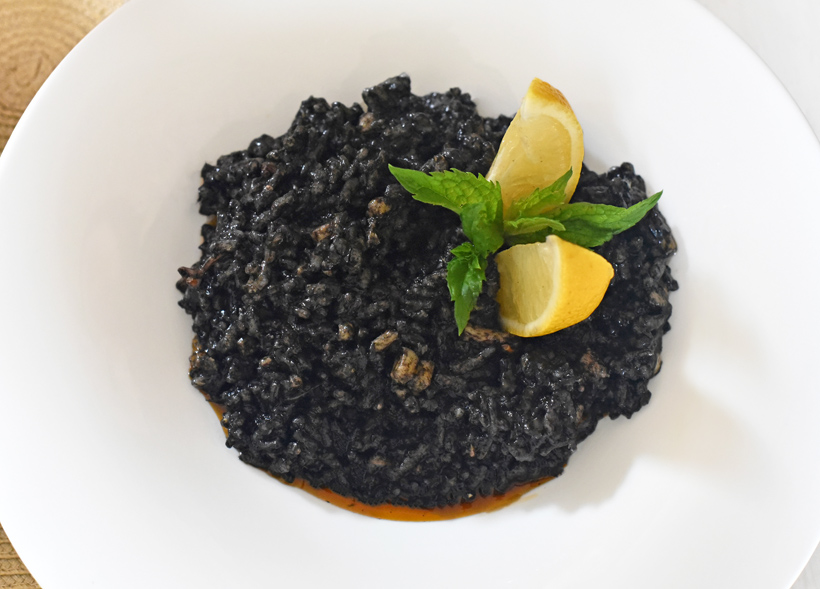
As tempted as I am to start all over and try the salted sardines and olive paste, I’ve chosen a different path for today’s recipe:
- First, what does cuttlefish taste like? It has a very mild generic seafood taste, like squid, and its ink has a briny flavor. To intensify these aromas, I’m using ingredients with a similar flavor profile: pink-red shellfish such as shrimp, and other foods that derive part of their aroma from colored pigments in the carotenoid family, like red pepper, paprika, and piment d’espelette. These pairings led me to create a special stock with shrimp and red pepper, plus chicken for additional body. Paprika and piment d’espelette are then used as seasonings in various parts of the recipe.
- A typical black risotto starts with frying onion and garlic, but as a nod to Pet Bunara’s obsession with leeks (at least at the time I dined there), I’m using the latter instead.
- According to Aldo Ivanišević, the basic preparation rule of black risotto is “the blacker the risotto, the better.” To get the blackest result possible, I’m mixing the stock used to cook the risotto with a generous amount of cuttlefish ink, then adding an additional color booster near the end of the cooking.
- Unfortunately, white rice doesn’t really turn black during the cooking – it just gets coated with a thick black sauce. To overcome this, I’ve tried using Venere Nero black rice, an Italian hybrid of Chinese forbidden rice with an Italian variety (available here). Its short ebony grains become dark purple when cooked, and the result is amazing. Just be advised that the black rice is slightly chewy, a subtle but noticeable departure from the usual risotto texture. You decide if you wanna give it a try or stick to good ol’ Carnaroli!
- Speaking of textures, to add some contrast, I’m complementing the risotto with cuttlefish strips and tentacles fried in batter. Like squid, cuttlefish is often thought to be rubbery. This is really caused by improper cooking – the correct cooking time should be either very short or quite long. Here we have both: quickly deep-fried pieces on top, and slowly simmered dice mixed into the risotto.

Add a couple more garnishes (a charred lemon, some deep-fried parsley leaves) and you get a rich, complex crni rižot.
Cuttlebones often wash up on the shores of European beaches. Cuttlefish are on the other hand completely absent from American coasts – and, as a result, from American stores. This leaves you with two solutions: special-order some from Citarella (one of the very few places that seem to sell imported cuttlefish on this side of the pond), or substitut with squid (because in the kitchen, once cleaned, cuttlefish are really just like large squid). Cuttlefish ink is more readily available, though again, squid ink is a perfectly valid replacement. The ink often comes in tiny packets that weigh just a few grams; as you calculate the amount you need, keep in mind that you’ll probably lose half a gram squeezing it out of each packet (the brand I found even included the plastic in the weight of the packet).

Aldo Ivanišević’s black risotto
Yields 4-6 servings
1 kg cuttlefish
300 g rice
parsley leaves
2-3 garlic cloves
45 g olive oil
1-2 onions
1-2 fresh tomatoes [or canned tomatoes, or tomato paste]
salt, pepper
- Clean and wash the cuttlefish, then cut into small pieces. When cleaning, separate the ink and stir it in a small cup of water.
- In a suitable pan, heat the oil and fry the chopped onion. As soon as the onion starts to color, mix in the garlic and parsley leaves. Then add the cuttlefish, salt, and pepper, and stir in the finely chopped fresh tomatoes, or crushed [canned] tomatoes, or tomato paste. Cover and cook over medium heat.
- When you estimate that the cuttlefish will be ready soon, pour a little warm water or, even better, fish stock or crab stock, and add the separately toasted rice. Stir and continue to cook until the rice is cooked through. Stir often and pour in warm water or fish stock little by little. The finished risotto should not be dry.
- A minute or two before the rice is cooked, stir in the prepared cuttlefish ink.
- Remove the finished risotto from the heat and serve after letting stand for a few minutes. Serve the risotto warm. You can season it with grated cheese.
Aldo Ivanišević’s additional ingredients and spices
When preparing the black risotto, you can add 1-2 dl of red or dry white wine, a little brandy or prosecco, a tablespoon or two of [wine] vinegar or balsamic vinegar, fish stock, light cream, lemon juice, celery leaves, lemon zest, pepper, thyme, basil, capers, paprika, sugar, laurel, chervil, rosemary, olive paste, butter, chopped hard cheese, cilantro, honey or herb seasoning.
You can omit tomatoes, onions or garlic, and add salted sardines, shellfish, squid, langoustine or prawn tails, also chopped Swiss chard or thinly sliced mushrooms, or chopped blanched almonds. With or instead of rice, you can use barley. You can mix cooked beans or peas into the almost finished risotto.
You can add the cuttlefish ink right after you add the cuttlefish, but it’s better to add it towards the end of cooking. But you can put a smaller portion of the ink earlier and a larger portion later. You can also make cuttlefish risotto without cuttlefish ink.
While cooking the risotto, instead of some or all of the water, you can pour fish soup or fish stock, reduced fish broth prepared from fish heads or fish leftovers.
[Right after this, Ivanišević includes a recipe for black and white risotto, consisting of 1/3 classic white risotto, finished with grated cheese and butter, and 2/3 black risotto. The two risottos should be served side by side without mixing, and their flavors are meant to be complementary.]
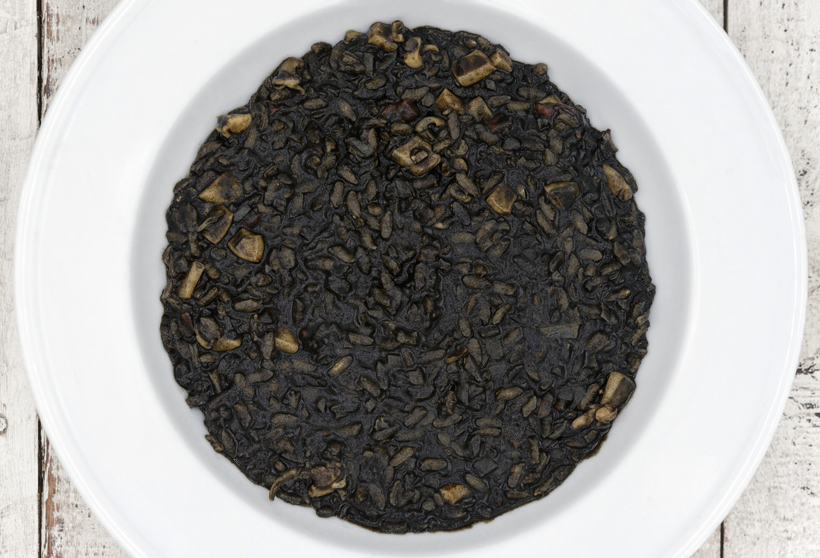
And now, for my recipe…
Red pepper, chicken, and shrimp stock
Yields about 1200 g stock (8 servings)
600 g chicken bones and/or wings and/or drumsticks
salt
25 g light olive oil
160 g peeled onions, large dice
80 g peeled carrots, large dice
160 g seeded red bell peppers, large dice
160 g leek greens, thoroughly cleaned, large dice
1150 g water
160 g shrimp heads and shells
15 g cognac
piment d’espelette
- Season the chicken pieces with salt. In the pot of a pressure cooker over high heat, sauté in half of the oil until brown on all sides.
- Add the onions, carrots, and red peppers, and cook for a couple minutes, stirring regularly. Season with salt, and add the leek greens and the water. Cover, bring to pressure, then cook under pressure for 1 hour.
- Remove the pressure cooker from the heat, and release the pressure progressively.
- In a pan over high heat, sauté the shrimp heads and shells in the remaining oil until bright red on all sides. Remove the pan from the heat, add the cognac, and flambée. When the flames are out, season with piment d’espelette.
- Open the pressure cooker, and add the contents of the pan to the stock. Cover again, bring back to pressure, then cook under pressure for another 20 minutes. Remove from the heat and let the pressure go down on its own.
- Pass the stock through a chinois, squeezing the juices out of the solids as much as possible. Let cool, and refrigerate. The stock can be kept in the fridge for a couple days, or frozen for months.
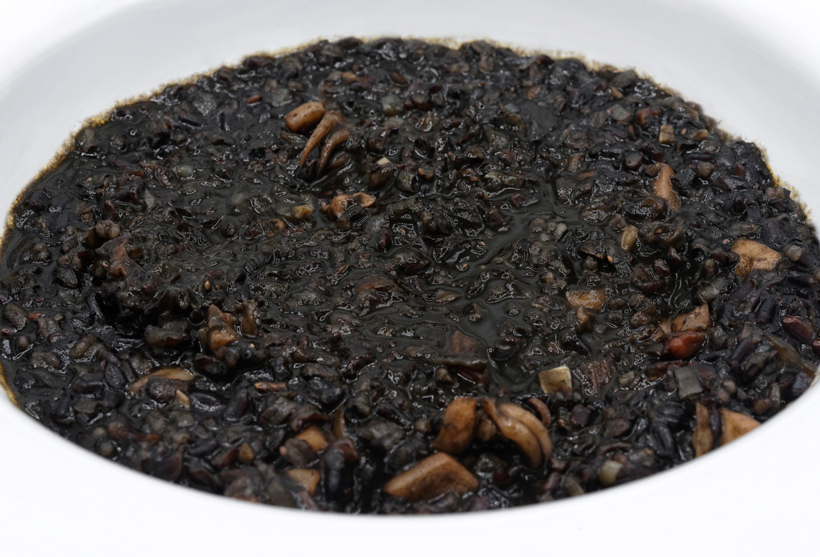
Black stock
Yields 2 servings
300 g red pepper, chicken, and shrimp stock
7 g cuttlefish ink
- Before making the risotto, bring the stock to a simmer in a small saucepan over high heat.
- Stir in the cuttlefish ink and reserve.
Charred lemon
Yields 2 servings
1 lemon
canola oil spay
- Cut off the lemon ends and discard them, then cut the lemon in half crosswise.
- Heat a pan over high heat. Spay with oil, and char the lemon halves (cut side down) for 2-3 minutes, until brown. Reserve.
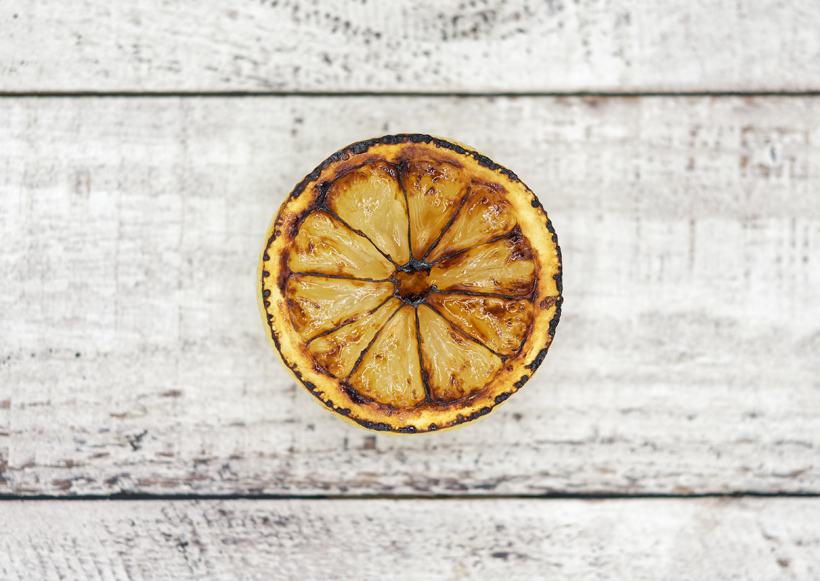
Risotto base
Yields 2 servings
100 g Venere Nero or Carnaroli rice
1 red bell pepper, whole
150 g cleaned whole cuttlefish
salt
30 g extra virgin olive oil
80 g cleaned leek (white part only), brunoise
5 g tomato paste
0.25 g piment d’espelette
65 g white or orange wine
150 g black stock, hot
- If using Venere Nero rice, cook the rice in a small saucepan filled with boiling water for 20 minutes, then drain and reserve. If using Carnaroli rice, don’t do anything at this stage.
- Char the red pepper on all sides on a gas stovetop or using a blow torch, Place in a bowl, cover with plastic wrap, and let rest for a couple minutes. Peel the pepper using paper towels, then rinse under cold water, pat dry, and discard the core and seeds. Measure 60 g of red pepper flesh and cut into a brunoise (you can reserve the rest for another recipe).
- For each cuttlefish, separate the tentacles from the body. Cut the tentacles in quarters lengthwise. Cut the bodies into 1 cm squares. Season with salt.
- Heat the olive oil in a saucepan over medium-high heat. Add the cuttlefish and leek, and sauté for 5 minutes, stirring regularly.
- Add the red pepper, tomato paste, and piment d’espelette, and cook for another 2-3 minutes, still stirring. Add the rice, and cook one more minute.
- Add the wine, and simmer for a minute, until the wine has almost evaporated.
- Season with salt. Add half the stock, bring to a simmer, then turn the heat to low, and cook until the liquid is completely absorbed. Repeat with the rest of the stock, then cover and reserve.
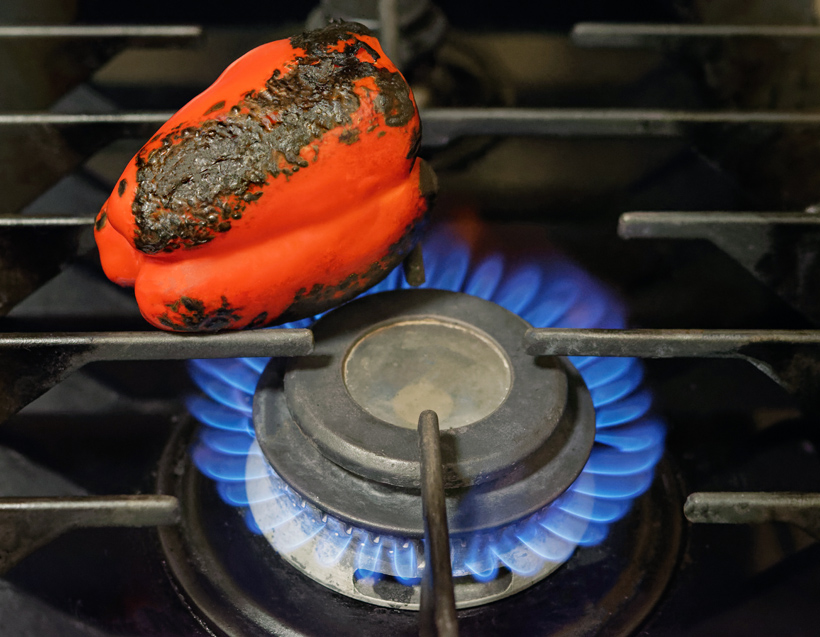
Paprika batter
Yields about 2 servings
25 g AP flour, sifted
10 g corn starch
1 g baking powder
0.5 g salt
1 g sweet paprika
50 g sparkling water
5 g olive oil
- In a bowl, mix the flour, corn starch, baking powder, salt, and paprika.
- Add the sparkling water and olive oil, and beat with a whisk until homogeneous. Let rest for 10 minutes.

Fried cuttlefish and parsley
Yields 2 servings
canola oil (for deep frying)
4 branches (about 4 g) curly parsley with stems trimmed
65 g cuttlefish
paprika batter
- In a large pot or a deep-fryer, heat the oil to 185 C / 365 F.
- Deep-fry the parsley for just 2 seconds (until the water has vaporized), then drain on paper towels and reserve.
- Separate the cuttlefish bodies from the tentacles. Cut the cuttlefish bodies into 0.75-1 cm thick strips (since they’re generally slit down the side to remove the innards and ink sack, they can’t be cut into rings), and the tentacles in half. Toss the cuttlefish in the batter and reserve.
- Just before serving, proceeding in batches if needed, carefully drop the battered cuttlefish into the oil. Fry just long enough to turn golden brown (about 45 secs for the rings, 1 min for the tentacles), flipping the pieces a few times with a spider. Drain on paper towels, and let the oil reheat before starting the next batch.
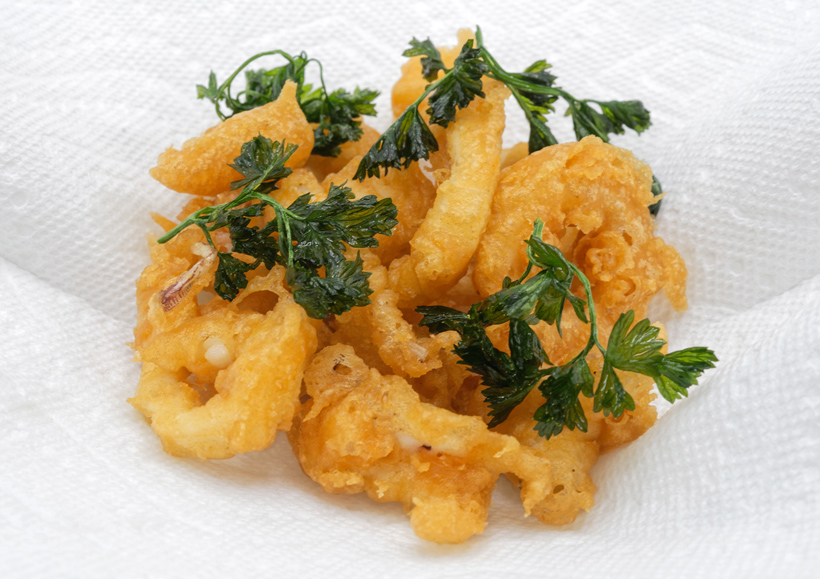
Assembly
Yields 2 servings
3.5 g cuttlefish ink
150 g black stock, hot
risotto base
10 g grated parmesan
10 g butter
salt
fried cuttlefish and parsley
charred lemon
- Mix the cuttlefish ink and about 30 g of the black stock in a small bowl, creating an extra-dark stock, and reserve.
- Return the risotto base to a burner set to medium-low heat. Add half of the remaining black stock, and simmer until fully absorbed. Repeat with the rest of the stock. Taste the rice — if it isn’t fully cooked, add a little bit of water (or stock) and reduce again.
- Finish the risotto with the reserved extra-dark stock, grated parmesan, and butter. Rectify the salt level. Stir, remove from the heat, and let sit for a couple minutes.
- Serve the risotto in bowls, topped with the fried cuttlefish and parsley and the charred lemon. Encourage your guests to squeeze the lemon over the risotto before eating.
